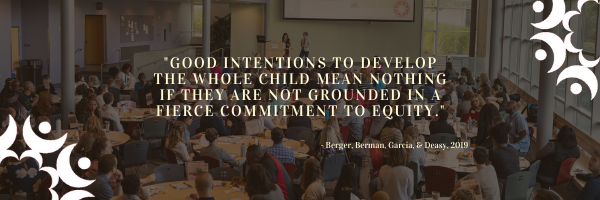
by Mona Grife
Almost every youth-serving organization and school district is aiming to increase their social and emotional supports for young people. This is in response to the mounting mental stress on students, teachers, and youth-serving professionals, which has come during this unprecedented time of school closures due to COVID-19 and due to the undeniable trauma that racism has caused in our Black students and families. In addition to learning spaces being re-imagined virtually, we are seeing a public outcry against injustice and anti-Blackness. This has been a catalyst to rise and ensure that our policies, practices, and actions do not perpetuate racism but instead move us toward creating inclusive learning spaces where every young person is thriving — especially our Black and Brown youth. As we revive our learning spaces, now is the opportunity to do better. Social and Emotional Learning (SEL) has the potential to move us in the right direction, but only if educational equity is our north star.
“Social emotional learning offers the possibility of acknowledging, addressing, and healing from the ways we have all been impacted by racism and systemic oppression and to create inclusive, liberatory learning environments in which students of color and students living in poverty experience a sense of belonging, [and] agency to shape the content and process of their learning, and thrive.”
– National Equity Project
A question that often comes up is, “What does this mean?” How can you ensure that SEL is a lever for educational equity? According to the National Equity Project, “Educational equity means that each child receives what he or she needs to develop to his or her full academic and social potential.” What does that look like in your school, program, or classroom?
The short answer is that the solution isn’t a SEL curriculum. It isn’t setting aside time for talking about emotions and doing mindfulness practices. Put simply, SEL is not just about the skills that we want students and adults to possess; it is about the characteristics of the learning space that encourage social and emotional skill development, which includes the climate and culture of that space.
When SEL reaches its full potential in learning spaces, every child feels a sense of belonging; every child feels seen and valued; and every child is empowered to learn, challenge, and lead. It will no doubt take a concerted effort with families, schools, and community-based organizations working in partnership to connect, align, and build this ecosystem of supports. We attempt to imagine what that ecosystem is in YDEKC’s Whole Child, Whole Day efforts.
There are some steps that leaders, educators, and youth-development professionals can take right now to plant the seeds to grow learning spaces that promote both SEL and equity.
- Support Adult Wellness — Provide intentional time for staff to reflect, breathe, and center themselves as part of professional development. Offer self-care opportunities at work, especially for staff of color. Spend time reflecting on social identity, implicit bias, and personal backgrounds and how this influences their actions and presence in the classroom/program.
- Center Relationships — Focus on creating a sense of belonging for everyone (youth and families) by co-creating community agreements, leading relationship-building activities, and recognizing each young person’s background, strengths, and story.
- Let Youth Lead — Ask youth for their opinions and how they would like to learn. Meet young people where they are at and give them opportunities to see how their efforts and voice can impact their communities.
- Incorporate Identity Development — Create time and space for youth to learn about, explore, and share their family’s history, cultural assets, and the amazing contributions and sacrifices that people of color have made to build this country. Connect and consult with mentors, educators, and elders who share similar backgrounds and histories to lead these sessions.
- Connect with Community — Create a community of learning for both families and youth. Reduce barriers by providing childcare, food, and a multi-lingual setting. Invite and include families in decision-making, programs, and events.
- Foster Real-World Connection — Create learning activities that incorporate relevant topics in youth’s lives. We cannot ignore racism, police brutality, or the inspiring efforts young people have led in this Black Lives Matter movement. Provide a variety of ways for youth to reflect, communicate, and share their thoughts.
These steps are based on learnings collected from YDEKC’s Whole Child, Whole Day mini-grantees in 2019. You can find out more about this project — including a downloadable PDF — in our Resource Center.
Interested in learning more?
Join us at our 5th annual SEL Symposium, Whole Child, Whole Day: Heart, Mind, & Body, a virtual learning journey across three days — July 24, July 31, and August 7th. We will start with challenging ourselves with self-reflection, wellness, and our social identity, and then we will move towards strategies and action steps for creating inclusive learning spaces.
You can also learn more about ensuring SEL efforts serve as a lever for educational equity by checking out the resources below.


